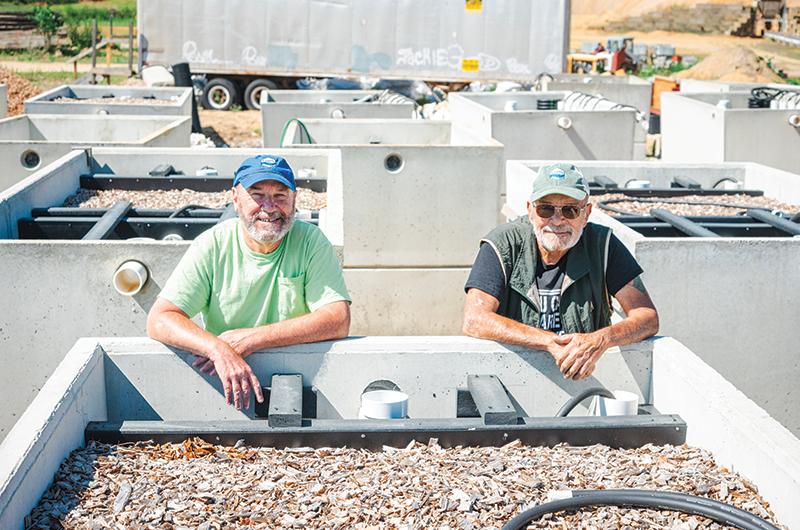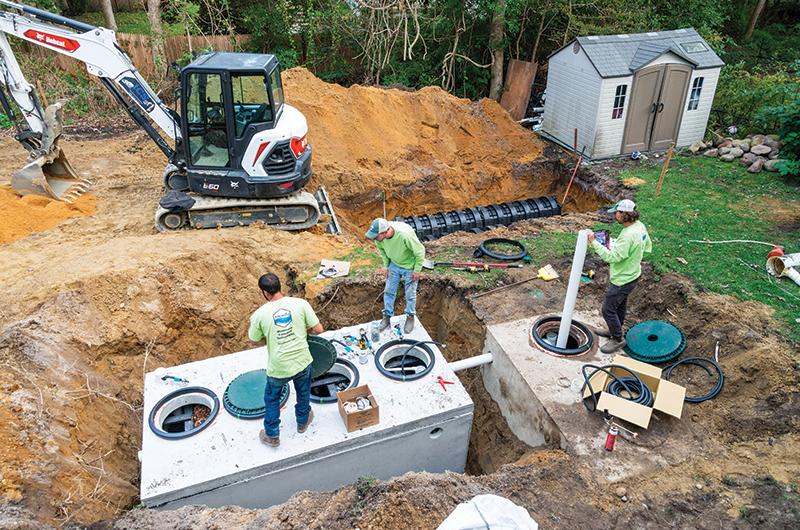The New Septic On The Block
Our homes, ponds, and wetlands depend on septic systems. New technology stands to change the way we think about our waste.
Martha’s Vineyard Magazine
November 13, 2023
THOMAS HUMPHREY
PHOTOGRAPHS BY RAY EWING
Well below sea level in Oak Bluffs, in the Goodale Construction sand and gravel mining pit, engineer and alternative-septic-technology inventor John Smith stands before a megalithic display of rectangular concrete tubs.
“After thirty years in engineering, this is the most satisfying work I’ve done,” he said, with a towering mound of bright-orange sand in the background. He wore a short, scruffy beard and a baseball cap embossed with his company’s name, KleanTu.
With that company, and the gargantuan enhanced septic tanks that surround him, Smith believes he has found the key to solving the Island’s wastewater problem. Which is to say the Island’s groundwater problem. And great pond water problem. And cyanobacteria problem. And shellfish and forage fish problem. And even, to some extent, its housing problem. Because it is houses, or rather the waste produced by the people who live in them and the fertilizers they put on their lawns and gardens, that is the primary source of the excess nitrogen slowly killing our ponds and streams.
To understand recent developments in septic technology, including the KleanTu system – and, for that matter, to understand why there are so many septic systems on-Island in the first place – we have to go back to the early days of septic. On Martha’s Vineyard, the best person to take us on that journey is environmental engineer Doug Cooper, who has completed roughly 4,000 septic inspections since he came to the Island in the ’90s.
“Really, septic technology is all rudimentary. It goes back to the 1930s,” he said. “You’re using the soil as a disposal medium for wastewater.” At their center is a simple mechanism, the septic tank itself: an impermeable, subterranean concrete receptacle for sewage. All pipes lead here, and upon arrival, previously commingled liquid and solid waste begins to separate. Solids settle to the bottom while liquids rise to the top. “The tank captures the solids and immediately bacteria, physical, and chemical processes begin to break it down,” said Cooper. “You can think of a septic tank as a liquid compost heap.”
Those solids break down over time, but only partially – they accumulate over a period of years, eventually requiring a pump-out. Meanwhile, as microbes go to work on the solids, liquid waste departs the tank through a pipe toward the top. From there, it flows outward into the leaching field, where a series of perforated pipes allow fluids to disperse into the soil.
This basic framework of the septic tank is an improvement over the open cesspits that typically preceded them, and which began to phase out in the late 1970s with the adoption of “Title 5” regulations by the state. Septic systems work pretty well at efficiently keeping raw waste and its associated health risks out of the surface environment. In terms of nitrogen removal, however, a traditional septic system does very little, removing only between 20 or 30 percent of nitrogen. “Once the septic water leaves the septic tank, the nitrogen removal is minimal through the leaching field, and it transmits down to the water table,” Cooper said. “That’s especially true in the sandy soils of, let’s say, the great outwash plain of Martha’s Vineyard.”
And so, as development accelerated across the Island and even more septic systems were buried in its sandy soils, nitrogen pollution steadily crept into Island watersheds, wreaking havoc on coastal ecosystems. The problem was compounded by what Cooper called a cultural “fear of sewers.”
Though centralized sewers remove nitrogen at a much higher standard (up to 97 percent), Island municipalities have generally been wary of the infrastructure, Cooper said, and not just because of the cost. They feared that more opportunity for sewer hookups might induce unwanted development. In Tisbury, for example, a wastewater treatment facility built in 2004 to address septic pollution was designed to be intentionally small in the hopes of limiting growth. When growth happened anyway, nitrogen from the new septic systems proliferated in Island ponds.

But what if septic tanks were more like miniature waste treatment plants, capable of removing excess nitrogen before it leached into the groundwater? Known as innovative/alternative (I/A) septic systems, technologies to this effect have been around for decades. They were much talked about in the early 2000s, when the damage being done to the Island’s ecosystem by nitrogen seepage was first becoming apparent. But they were only occasionally installed, typically by wealthy homeowners who wanted to skirt zoning regulations and build larger houses.
On a house lot in a nitrogen-sensitive area, Cooper explained, zoning regulations might dictate a certain number of bedrooms allowable in building plans. “One of the things you could do to get more bedrooms on a lot was to treat your wastewater better,” he said. “And the way to treat your wastewater better was to use these innovative/alternative septic systems.”
Those early I/A systems, Cooper said, were based on wastewater treatment technology that had been around since the 1950s. In a process he likened to “going from vacuum tubes to transistors,” the tech used in sewer plants was miniaturized to work for a single home.
But the systems, complex and expensive, were never widely adopted on-Island. Which left Smith, an engineer with an eye always tuned to efficiency, unsatisfied with the state of play.
“Everyone just took a big wastewater treatment plant, and they miniaturized it; that’s all they did,” he said. “We wanted to come up with something different.”
Enhanced septic systems, such as the one being developed by KleanTu, catapulted back into the wastewater conversation last winter when the state Department of Environmental Protection (DEP) released draft revisions to their “Title 5” septic regulations. Under the proposed regulations – which were planned to take effect first on Cape Cod before coming to Martha’s Vineyard, Nantucket, and the South Coast – towns with sensitive watersheds could either apply for a “watershed permit” with plans to significantly reduce nitrogen pollution, or else be required to upgrade all the septic systems in the watershedto enhanced systems.
On the Cape and Islands, where tens of thousands of septic systems dot dispersed, rural communities, upgrading them all would cost hundreds of millions of dollars, if not more. Statistics on the total number of septic systems on-Island are difficult to come across, with experts guessing that the number could be anywhere from 6,000 to 10,000. Meanwhile, records indicate there are currently around 500 I/A systems on the Island. If only 5,000 septic systems had to be replaced (a conservative estimate), such a project could cost around $165 million. Whether paid for by homeowners, local property taxes, grant funding, or some combination, the potential impact on home affordability in an already tight housing market is immense.
This June, following an extensive and sometimes heated public comment period, the DEP released the final version of the new regulations, with one critical change: the Vineyard, Nantucket, and the South Coast were no longer slated to be a part of those regulations. Always primarily focused on the Cape, plans for the regulations to be implemented elsewhere were removed after the DEP received significant pushback from many communities slated to be included, especially on the South Coast.
The pullback fit well within the storied tradition of kicking the can down the road on water quality. Indeed, the DEP only released the revisions – the biggest change to the septic code since 1994 – under legal pressure. The Conservation Law Foundation had sued them for knowingly neglecting their obligation to stop septic pollution on Cape Cod.
Still, it’s hard not to get the impression that momentum is building, and most observers think the Islands will eventually be put back under the new regulatory regime. “The new Title 5 regs, they’re not here for us yet. But they will come,” said Sheri Caseau, the Martha’s Vineyard Commission (MVC) water resource planner, “and I don’t think that will be too far along.”

Caseau is one of several planners working on an up-Island watershed management plan to cover Chilmark, West Tisbury, and Aquinnah. Additionally, planners in Edgartown, Oak Bluffs, and Tisbury are all working on management plans for those towns. All are being developed so that they could be used for a watershed permit of the sort now required on the Cape, she said, and all envision an increase in the use of alternative septic systems.
“I/A’s are number one in our toolkit,” Caseau said of the up-Island plan, and such systems will also play a part down-Island.
This is where Smith, and KleanTu, come in. The KleanTu technology, Smith claims, is more effective and simpler than older I/A systems. Their systems are also constructed locally, easing logistics issues. Now, as orders for his product skyrocket on the Cape and the Vineyard, Smith believes his time has come, and he is ready to spread the gospel of enhanced septic systems.
If he is right, it could be a watershed moment for Island watersheds.
As the sun beat down on towering sand piles at Goodale’s pit, KleanTu’s vice president of field operations Richard Donahue mounted a stepladder to inspect one of the company’s NitROE septic tanks, a technology he helped develop.
If Smith is the visionary behind KleanTu, then Donahue is the man that brought vision into reality. The two men met when Donahue had a caretaking business and looked after Smith’s Edgartown home. During that time, Donahue recalled, Smith would regale him with stories from his environmental engineering work across the globe.
“He used to bring me back booze from all over the world, from Russia and Taiwan and Macau,” Donahue said.
Donahue peered into the tank through a pair of translucent amber aviators, his skin deeply tanned after decades of work outdoors. “I used to tell John that I had a personal relationship with the bugs in here,” Donahue recalled of developing the system, which uses microbial processes to break down the nitrogen in household sewage. Unlike other I/A systems, the KleanTu septic requires few mechanical components and no chemical inoculants to maintain its biotic processes, reducing both upkeep and cost while removing at least as much nitrogen as other I/A systems.
“I told him, ‘You’re too much of an engineer, you’re a math man…but you gotta think like a bug.’ We’re talking about living things here,” Donahue added.
In concept, KleanTu’s NitROE system picks up where a conventional septic system ends: rather than liquid waste exiting the tank through a leaching field, it flows into the two-chambered NitROE tank for additional treatment. First, it enters the aerobic chamber, half of which is loaded with little black plastic florets called bio rings, dahlia-shaped bacterial hotels for the microbes to colonize that are widely used in aquarium systems. The other half is mounded with limestone, providing chemical components necessary for the bacteria to do their job. In the presence of oxygen bubbled in from above ground, the bacteria ingest ammonia compounds from urine and turn them into nitrates.

Those nitrates then flow into the second chamber, an oxygen-less (anaerobic) environment packed with wood chips that is host to a wholly different microbial community. There, the microbes convert nitrates into nitrogen gas. That gas is then vented off into the atmosphere, which is already 78 percent nitrogen.
The result, Smith says, is a highly efficient and highly scalable system. For larger projects with more projected waste, the two chambers can be split into separate tanks, and more tanks can be added indefinitely. Another advantage KleanTu has over other I/A systems, at least on the Cape and Islands, is that it is manufactured locally, both at Goodale’s pit and at Acme-Shorey on Cape Cod. When a product consists primarily of heavy and bulky concrete tanks, transportation costs are not insignificant.
When Smith first approached him with the idea for the system, Donahue said he had already spent decades watching water quality degrade on-Island. “He called me and told me what [the system] did, that it was going to remove the nitrogen. And I said ‘Hey, let’s give it a shot,’” Donahue said. “I knew it was a good idea because I lived here so long. I mean, who doesn’t love getting a mess of clams?”
But while the system sounded simple enough, moving from concept to execution was a challenge, requiring years of collaborative tweaking between the two. In his work engineering wastewater systems, Smith said, he has dealt with the whole range of water contaminants, from the carcinogenic Polychlorinated Biphenyl to good old-fashioned cyanide. “I thought this would be a piece of cake,” he said of nitrogen removal. “Boy, was I wrong.”
Now, however, the pair has tuned the system in to where they want it, with tests indicating an average nitrogen removal rate of around 93 percent. But though Smith says he is ready to roll out KleanTu on a large scale, for planners the questions remains: is I/A septic really the best way to go?
Cooper, who spent much of his previous career working to find ways to avoid municipal sewers, is not so sure. “Let’s face it, if we’re serious about protecting the ponds, we have to take a serious look at sewering,” he said.
Different neighborhoods, he explained, call for different solutions. Take, for instance, Ocean Heights, the densely populated neighborhood bordering Sengekontacket Pond on the Edgartown side. Its small, concentrated lots are the model of where centralized sewering might work, he said, and the possibility of hooking the area up to sewer is being considered as part of the Edgartown wastewater planning process.
“Now, when you get up to West Tisbury,” he said, “that’s where I can see I/A systems really making a difference.” For sparse, rural neighborhoods in the three up-Island towns, it is difficult to imagine an alternative to I/A systems, but installing them on such a large scale also poses problems. Each of the systems must be monitored to ensure continued functioning.
“If that state regulation were going to mandate everybody put in these I/A units, I cannot imagine a scenario where there was the workforce available to monitor and manage all those systems on-Island,” Cooper said.
Currently, all the Island towns except Aquinnah outsource their I/A data services to the mainland, to the Barnstable County Septic Management Program. Brian Baumgaertel, who heads up that program, said towns on the Cape have already been struggling to keep up with monitoring needs as more I/A systems go in. “It’s not just the specter of increasing demand for those services, but also decreasing supply, as [current workers] are retiring out and not being replaced,” he said.
The problem of funding I/A systems and their monitoring, which now mostly falls on the back of the homeowner, is another source of friction. “If we’re talking about somebody who wants to add a third bedroom, then that’s part of the cost of adding a third bedroom,” Baumgaertel said. “But now we’re talking about potentially using these systems as a means of protecting our bays and estuaries and requiring people to put them in for a different purpose.”
One option is for towns to take over management of the systems, along the lines of a municipal sewer funding, with homeowners paying into a town program that manages septic monitoring contractors. Tisbury is currently considering this approach.
Regardless of whether sewering, I/As, or some combination of the two is chosen, the change in wastewater planning is sure to be expensive. With Cape regulations now casting a heavy shadow over the Island, kicking the can down the road may no longer be an option.
“People need to pay attention to what’s happening in their communities,” said MVC water resource planner Caseau, “because it’s going to affect their pocketbooks.”
While sewer infrastructure upgrade projects remain largely in the planning stages, I/A septic seems to have captured the zeitgeist of nitrogen removal. In nitrogen-sensitive areas around Sengekontacket Pond and Lake Tashmoo, for instance, every time a septic is installed or replaced, it must be an I/A system.
KleanTu installed just one system in 2017, their first year of operation, but in 2022, that number jumped to twenty-six. In 2023, Smith said, they expect to install at least thirty-nine systems.
As plans move forward, Smith continues to proselytize the gospel of enhanced septic. “You know, I believe in fate,” he confided, driving his truck through the industrial landscape of Goodale’s pit. “Coming here and meeting Richard, he and I were meant to do this. This is our calling.”
